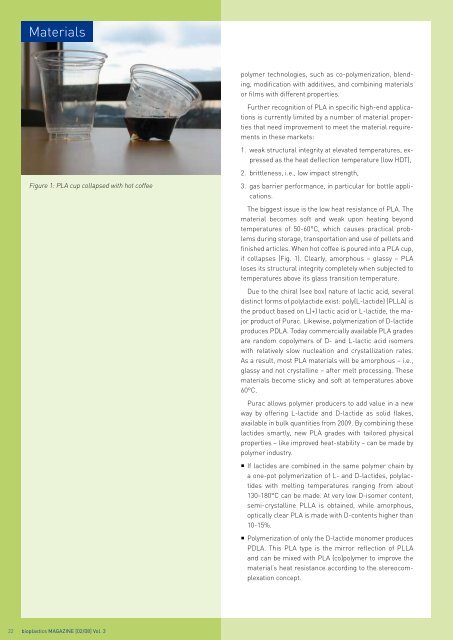02 | 2008
Create successful ePaper yourself
Turn your PDF publications into a flip-book with our unique Google optimized e-Paper software.
Materials<br />
polymer technologies, such as co-polymerization, blending,<br />
modification with additives, and combining materials<br />
or films with different properties.<br />
Further recognition of PLA in specific high-end applications<br />
is currently limited by a number of material properties<br />
that need improvement to meet the material requirements<br />
in these markets:<br />
1. weak structural integrity at elevated temperatures, expressed<br />
as the heat deflection temperature (low HDT),<br />
2. brittleness, i.e., low impact strength,<br />
Figure 1: PLA cup collapsed with hot coffee<br />
3. gas barrier performance, in particular for bottle applications.<br />
The biggest issue is the low heat resistance of PLA. The<br />
material becomes soft and weak upon heating beyond<br />
temperatures of 50-60°C, which causes practical problems<br />
during storage, transportation and use of pellets and<br />
finished articles. When hot coffee is poured into a PLA cup,<br />
if collapses (Fig. 1). Clearly, amorphous – glassy – PLA<br />
loses its structural integrity completely when subjected to<br />
temperatures above its glass transition temperature.<br />
Due to the chiral (see box) nature of lactic acid, several<br />
distinct forms of polylactide exist: poly(L-lactide) (PLLA) is<br />
the product based on L(+) lactic acid or L-lactide, the major<br />
product of Purac. Likewise, polymerization of D-lactide<br />
produces PDLA. Today commercially available PLA grades<br />
are random copolymers of D- and L-lactic acid isomers<br />
with relatively slow nucleation and crystallization rates.<br />
As a result, most PLA materials will be amorphous – i.e.,<br />
glassy and not crystalline – after melt processing. These<br />
materials become sticky and soft at temperatures above<br />
60°C.<br />
Purac allows polymer producers to add value in a new<br />
way by offering L-lactide and D-lactide as solid flakes,<br />
available in bulk quantities from 2009. By combining these<br />
lactides smartly, new PLA grades with tailored physical<br />
properties – like improved heat-stability – can be made by<br />
polymer industry.<br />
• If lactides are combined in the same polymer chain by<br />
a one-pot polymerization of L- and D-lactides, polylactides<br />
with melting temperatures ranging from about<br />
130-180°C can be made. At very low D-isomer content,<br />
semi-crystalline PLLA is obtained, while amorphous,<br />
optically clear PLA is made with D-contents higher than<br />
10-15%.<br />
• Polymerization of only the D-lactide monomer produces<br />
PDLA. This PLA type is the mirror reflection of PLLA<br />
and can be mixed with PLA (co)polymer to improve the<br />
material’s heat resistance according to the stereocomplexation<br />
concept.<br />
22 bioplastics MAGAZINE [<strong>02</strong>/08] Vol. 3


















